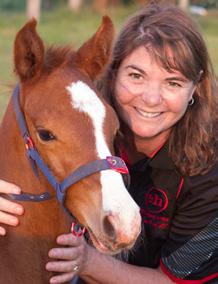
7 minute read
Brister’s Brief
PUBLISHER’S LETTER
From the Horse’s Mouth
With Fiona Todd
As the strangest year ever continues to roll along, the craziness in which we find ourselves means that one of my favourite celebrations will be a little different this time around. I always cherish the company of my very beautiful family, but Father’s Day is a special time and Dad and I usually enjoy raising the inevitable glass of bubbles together. This year we’ve been forced to do a long distance celebration. Trust me Dad, I would hug you if I could. Thank you for being you x.
The September/October issue is inspiring, to say the least. Congratulations to everyone who submitted an application for the Delivering Dreams Scholarship. The quality of applicants is very impressive and we’re currently shortlisting before handing the finalists over to our panel of judges. The lucky recipient will be named in our November/December issue.
Which brings me to the wonderful Spotlight, written by our editor Amanda Mac, on the life and times of champion dressage rider Brett Parbery. Talk about a never say never attitude! The highs and lows of his life have been jaw-dropping, yet he continues to approach it all with a sense of optimism and gratitude.
Resident columnist Charlie Brister looks at lunging, a training tool that’s often either poorly used or underutilised. As usual, Charlie brings no nonsense, simple techniques that will help you to move your horse’s training forward. And stay tuned for details of The Right Rein, a super informative podcast hosted by Charlie. Launch date to be announced soon – and yes, we’re very, very excited!
Following on from the popular Brumby article in our last issue, Marisa Kuhlewein talks to Brumby photographer Carol Hancock in a fascinating Culture Corner. Carol’s passion for the Snowy Mountain Brumbies absolutely shines out of her stunning multi-award-winning work.
And if you’ve ever hunted high and low for a new horse and found it near impossible to find ‘The One’, then imagine being a Pararider with the difficulties they face and the enormous level of trust they have to place in their mount. This article brought tears to my eyes. The riders interviewed, Emma, Sue-Ellen and Katie are three of the most inspirational people I’ve ever met. Plus, we have some autographed copies of Sue-Ellen’s book Johno and the Blind Chick to give away, so watch this space.
If you thought saddle fitting was important (and it certainly is), wait till you catch Anna Minogue’s take on bit fitting. She explains how vital it is to get it right, and warns of the potential for painful injuries if you don’t. Meanwhile, champion showjumper Aaron Hadlow found time in his crazily busy schedule to offer some sound advice on how to bring horses back to fitness after spelling or from injury. Patience seems always to be the answer!
On matters of travel - well, armchair travel anyway - Sonia Caeiro Alvarez whisks us off for a virtual riding holiday in WA’s glorious Kimberleys, while Roly Owers, Chief Executive of World Horse Welfare, climbs onto the Tackbox to have his say on the very broad concept of animal well-being.
Curious to know what acupuncture is? How it is helps? Equine acupuncturist Ben Walder reveals all. In Training Tips, Amanda Clifford brings us expert advice on horse-centred training, and our Horse Listener takes a fascinating look at how horses see.
But of course, there’s more! We explore rugs, Riding Ponies and review the Bates Innova saddle. Jo McKinnon investigates a Hong Kong based OTT Thoroughbred retirement program, and Neil Quinlan’s Horses in History has now morphed into our new feature, Perfect Partners, launching in this issue with the amazing story of Gillian Rolton and Peppermint Grove.
And to close out the day, Charlie Brister asks Dan James 20 searching questions.
Phew! Pour your favourite tipple, sit back and enjoy, and remember to send your dad a cheers
Always fold the lead in your hand, never wrap it around your hand or your arm (an easy and potentially dangerous mistake to make).
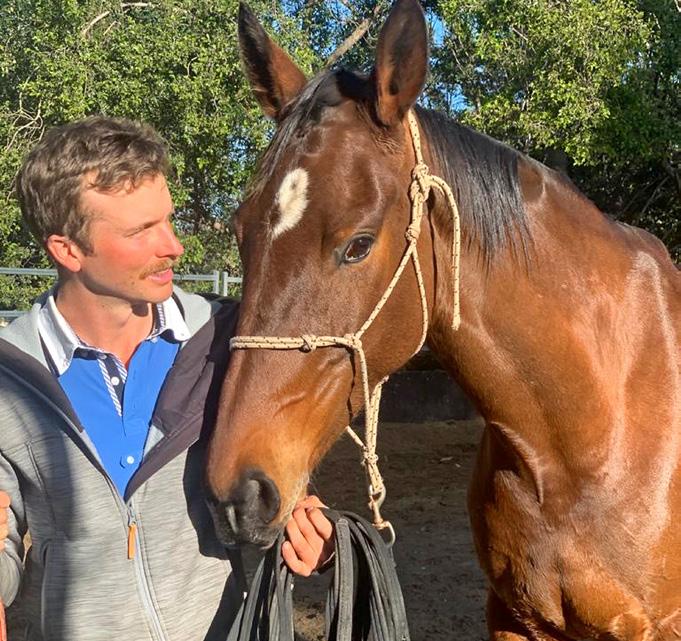
BRISTER’S BRIEF
Lunging: It’s a circular question
Is lunging the magic cure-all? In Part One of this three-part feature, resident columnist CHARLIE BRISTER digs deep on the subject of circles.
Everyone has either ridden a horse or watched one being ridden and thought: “Whoops, should have lunged that camel!”
In its most basic form lunging can be an effective tool for dispersing excess energy, while more advanced lunging techniques can help the horse to improve transitions, build responsiveness and stretch the top line. BUT, be mindful that lunging is only one component of good groundwork – it’s not a short cut to the miles necessary for a calm school master.
Does lunging calm the horse down?
Lunging is no silver bullet. Quite often it’s the horse who lunges the poor rider who just gets dizzy, exasperated and bucked off anyway. If your pampered,
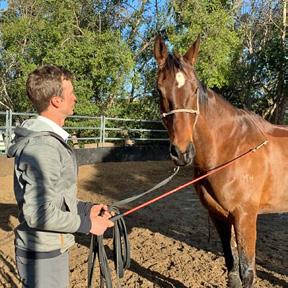
and possibly overfed pony is a little too animated, you may think that the best way to get rid of all that vibrant energy is to lunge them.
Mmm … let’s be a little more scientific. Let’s try to identify what might be causing your horse to behave like an energizer bunny inside a pinball machine.
Firstly, check their feed is properly balanced and appropriate for the work you’re doing. Unless the Melbourne Cup or an Olympic cross country course is on your horizon, lower the intensity of energy and protein - less pellets, more roughage. Hay is your friend. Get some expert advice (but not from the local grain merchant!).
Remembering that regular lunging for long periods will just make your horse fitter so that they can bounce around for longer, changing the diet could be a better long-term solution to bad behaviour!
Secondly, try to have a longer ride the day before the competition, and on the day, consider a short ride before loading up and heading out. This can really help with a young or a hot horse, although some horses just aren’t calm by nature.
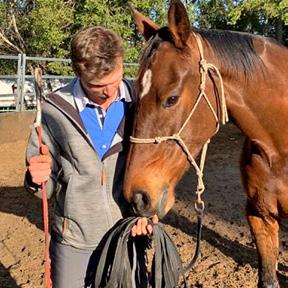
Appropriate lunging can improve the horse
Make sure lunging is interesting and requires the horse to concentrate. This way you can work through excess energy while also improving your horse’s work.
While your horse is walking and trotting around the yard pay attention to the way their body moves. On which part of a circle do they drift in or out? Do they fall in on the left or the right rein? Most horses will have one side that’s a little more convex than the other, and lunging can really help the horse develop its straightness. The other thing to focus on is the horse’s consistency of tempo. Don’t start looking for the perfect frame
‘working over the back’ straight away – get the basics down first.
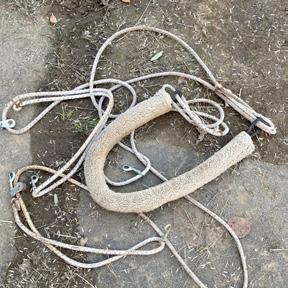
I’m sure he loves me: MT Henry Irish Spice, aka Spike A Saurus Rex, aka Spike, unashamedly smoodging.
Desensitising your horse to the gear you use will help them to be calmer when they enter the lunge area.
This system is designed to position the horse’s head, but why not use good timing and technique instead!
Lunging area and equipment
A great lunge yard is 20m across, but some are as small as 12m. If your horse is really fresh, a fenced yard is preferable so that you don’t get towed around the paddock. A dressage arena also works well. Use the extra space and move your circles up and down the arena while your horse is working on the lunge around you. This will show if they are drifting to the gate or if they are listening and following you.
Lunging can incorporate different tools, including cavessons, side reins, Pessoa, flag, carrot stick … the list goes on. It’s easy to get confused about what’s best.
Similar to other areas of riding it’s not the tool so much as how you use it, and a well-schooled horse might happily lunge at liberty.
Make sure you have thoroughly habituated/desensitised the horse so that it’s not afraid of the gear you are using – especially the long whips. Instead of being in flight mode, a horse should be calm when you enter the lunge area, which will minimise the likelihood of bad behaviour.
Go straight before upgrading to circle work
To focus on a horse’s tempo and line, make sure you can back the horse up and bring them forward off the halter pressure easily. If this is hard then chasing them around in a circle won’t be helpful.
Always give the horse a chance to respond to the lead pressure before using the whip. Let’s say your horse is remaining stationary looking at you with a puzzled expression wondering what’s going. Now you need to motivate










